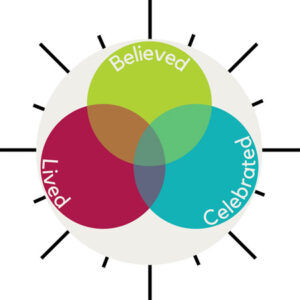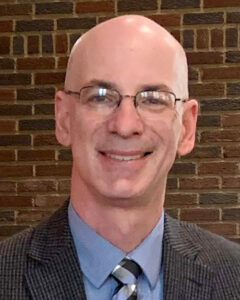 By David Pitt
By David Pitt
Eucharistic Revival
The past month has been professionally difficult. I haven’t been able to turn on the radio or go into a store without being reminded that Christmas is coming (or at least that Santa Claus is coming to town!). As I drive down the street, Christmas lights twinkling on either side, Christmas music playing on the radio, I haven’t been able to escape that “the Christmas season” is already upon us. As tempting as it is to subscribe to slogans such as, “Jesus is the reason for the season” or “keeping Christ in Christmas,” even these fall short. We are used to thinking of Christmas as being the celebration of Jesus’ birth and Advent as being the season of preparing for Christmas.

These descriptions are not inaccurate, but incomplete. The Nicene Creed offers an important clue of what the Church intends, identifying how Jesus Christ, “by the power of the Holy Spirit was incarnate of the Virgin Mary.” The word “incarnate” is more than “born.” Incarnate is based upon the root word “carne” — meaning meat or flesh (think of “carne asada”). In Jesus, God took on flesh. The season of Christmas, taking its cue from the Solemnity of Christmas (Dec. 25), is dedicated to celebrating and recognizing God’s incarnation, God’s enfleshment. The original Gospel reading for Christmas Day set the tone: “In the beginning was the Word… and the Word became flesh” (John 1:1, 14). The season of Advent is not so much dedicated to preparing to celebrate the birth of Jesus as it is about preparing to recognize God’s incarnation in the many and varied ways it occurs.
After Christmas day, the feasts within the Christmas season develop the foundational recognition of God’s incarnation. Of particular note is Dec. 26, the feast of St. Stephen the martyr. The author of the Acts of the Apostles wanted us to know that in seeing the witness of Stephen, we are seeing Jesus Christ. Stephen enfleshes Christ in how people react to him (Acts 6:11-12 and Luke 22:66, 70-71) and in how he dies (Acts 7:59-60 and Luke 23:34, 46).
By extension, all those who die deaths like Christ make Christ present in their own bodies. Dec. 27 is the feast of St. John, the apostle and evangelist. As the Second Vatican Council teaches, the Word is made flesh in the writing down of Scripture and in its proclamation within the liturgical assembly. All those who wrote Scripture, and the many more who proclaim it, make Christ present in their bodies.
Dec. 28 is the Feast of the Holy Innocents — those under the age of 2 massacred by Herod (Matthew 2:16). How can we see Christ enfleshed in these helpless ones? The same way, Matthew tells us, that we might see Christ present in the hungry, thirsty, stranger, naked, sick and imprisoned (Matthew 25:42-43). Christ is enfleshed in “these least ones” (Matthew 25:45).
Two feasts of Mary are particularly crucial for understanding incarnation: Jan.1, the Solemnity of Mary, Mother of God, and Dec. 8, the Solemnity of the Immaculate Conception of Mary. Underlying the Solemnity of Mary, Mother of God, is the ancient debate about when the human Jesus “became” God. Was Mary the mother of only the human nature of Jesus? Could a human being give birth to his divine nature as well? The Council of Ephesus (431) declared that Mary was the mother of the whole Jesus — human and divine. She was the mother of God; Jesus could not be split apart.
The Solemnity of the Immaculate Conception of Mary celebrates the reason it was possible for Mary to consent to be the Mother of God: she was conceived in the womb of her mother without the stain of original sin. Thus, when God, through Gabriel, asked Mary whether she would accept God’s offer to be an unwed teenage mother in a culture oriented around honor and shame, she said yes — because she trusted completely in God’s will.
Mary is, of course, unique. As St. Paul VI noted, she is also “the first and most perfect of Christ’s disciples,” particularly “worthy of imitation.” By virtue of our baptism, we also have been cleansed of original sin in the font, the womb of the Church. Therefore, we have the opportunity to say yes to God enfleshed in the Eucharist. Jesus says, “Whoever eats my flesh and drinks my blood remains in me and I in him” (John 6:56).
Saying “Amen” in Communion, we make Mary’s response to Gabriel our own. “So be it.” Accepting the presence of God in Christ within us as gift, we assume the responsibility for making the presence of Christ within us visible to the world. Eucharistic Prayer III highlights what we pray will happen: “Grant that we, who are nourished by the Body and Blood of your Son and filled with his Holy Spirit, may become one body, one spirit in Christ.”
We pray that we will faithfully enflesh the presence of Christ. We know that like the Holy Innocents in their neediness, Jesus is enfleshed in us. We pray that like John, we will embrace the vocation to proclaim God’s word and faithfully acknowledge that the Word is enfleshed in us. We pray that we, like Stephen, will live lives and die deaths that faithfully acknowledge Christ enfleshed in us.
This responsibility will keep going long after the Christmas lights have been turned off and the radio stations, stores and our homes have boxed up the sounds and sights of Christmas. The words of the Father to the Son as the Spirit descended upon Jesus at his baptism (the final feast of the Christmas season) apply to us as well. As we consent to God’s will, we are God’s beloved, in whom God is well pleased.
(David Pitt, Ph.D., is associate professor of Theology at Loras College in Dubuque, Iowa.)











